What Is Cross Arm, Jumper, And Guarding in Overhead Lines
Hello, guys welcome back to our blog, In this article, we will discuss what is cross arm, Jumper, and guarding in overhead lines. That means types of cross arm, what is a jumper in overhead line, and guarding in overhead lines.
If you have any electrical, electronics, and computer science doubts, then ask questions. You can also catch me on Instagram – CS Electrical & Electronics.
Also, read:
- Top 12 Microcontroller Manufacturing Companies In The World
- Top 100 Electronics Companies In The World To Work For Growth
- Top 12 Electrical Switch Manufacturing Companies In The World
What Is Cross Arm, Jumper, And Guarding
What Is Cross Arm?
The function of line support (pole) is to support the line conductors at a safe distance from the ground whereas the function of cross arms is to keep the conductors at a safe distance from each other and from the pole.
Cross Arm is a cross-piece fitted to the pole top end portion by means of brackets, known as pole brackets, for supporting insulators. Cross arms are of various types such as MS channel, angle iron, or wooden. These may be straight, U-shaped, U-shaped, or zig-zag shaped, as shown in the below image.
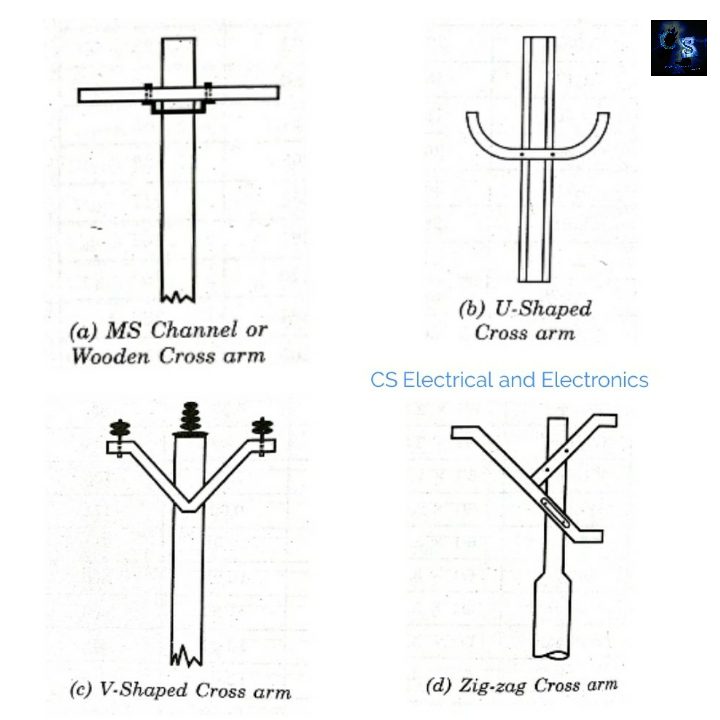
Wooden cross arms are commonly employed on 11 KV and 33 KV lines. These are made of sal wood, seasoned Sheridan wood, or creosoted firewood.
Grains of wood cross arms should be length-wise and completely free from knots. Wooden cross arms are preferred owing to their insulating property which provides safety to line staff and minimizes flash-over due to the bridge.
The usual lengths and x-sections of wooden cross arms in use are 1.5m×125mm×125mm for 11 KV lines and 2.1m×125mm×125mm for 11 KV lines and 2.1m×125m×125mm for 33 KV lines. Wooden cross arms need replacement owing to decay after 5-7 years depending upon weather conditions.
Steel cross arms are stronger and are generally used on steel poles. For lv distribution, the angle iron or channel iron cross arms shall be of a size not less than 50mm×50mm×6.4mm and 76mm×38mm. The length of the cross arms shall be suitable for the spacing of the conductors.
Cross arms shall be suitable and strong enough to withstand the resultant forces caused by insulators, their pins, the deadweight of insulator attachments, etc. To avoid birdcage on HT lines, V-shaped cross arms are used with pin insulators while straight cross arms are used with disc insulators.
The cross arm is fixed to the pole in such a manner that the load of the conductors is taken by the cross arm and not the clamp or bolt that fixes the cross arm to the pole.
What are Jumpers in overhead lines?
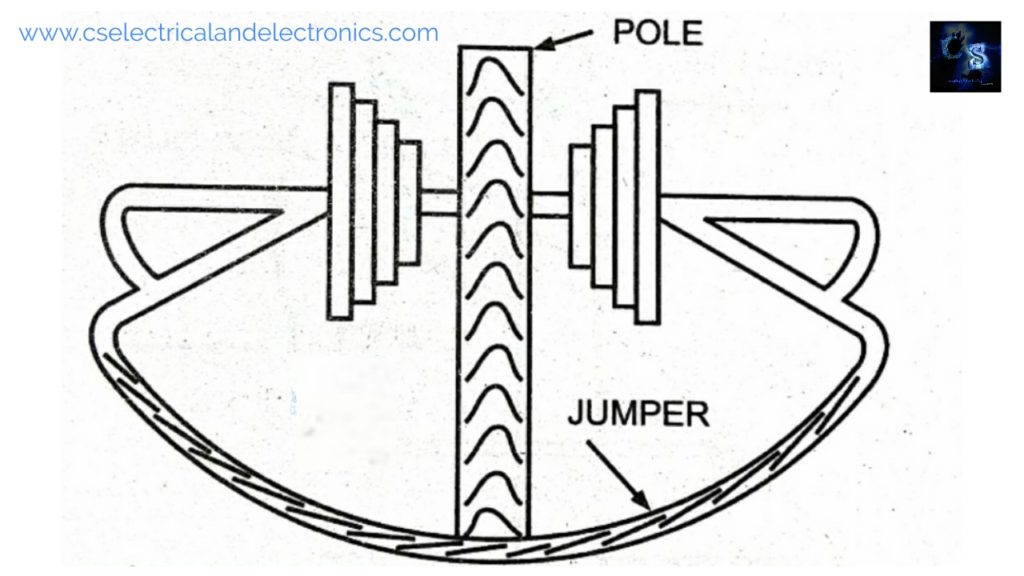
In a straight run, one terminal pole is provided after every kilometer so as to facilitate sagging. The short length of the conductor employed to connect the line conductor on one side of the terminal pole to the line conductor on the other side of the terminal pole is known as the jumper.
A jumper is made of the same material and has the same current-carrying capacity as that of the line conductor. Jumpers are fixed to the line conductors with a suitable clamp. For HV lines the jumpers are arranged in such a way that under the maximum deflection condition there is a minimum clearance of 0.3m between the line jumpers and the other metallic parts. PVC sleeves or porcelain beads are provided on jumpers to avoid birdcage.
What is guarding in overhead lines?
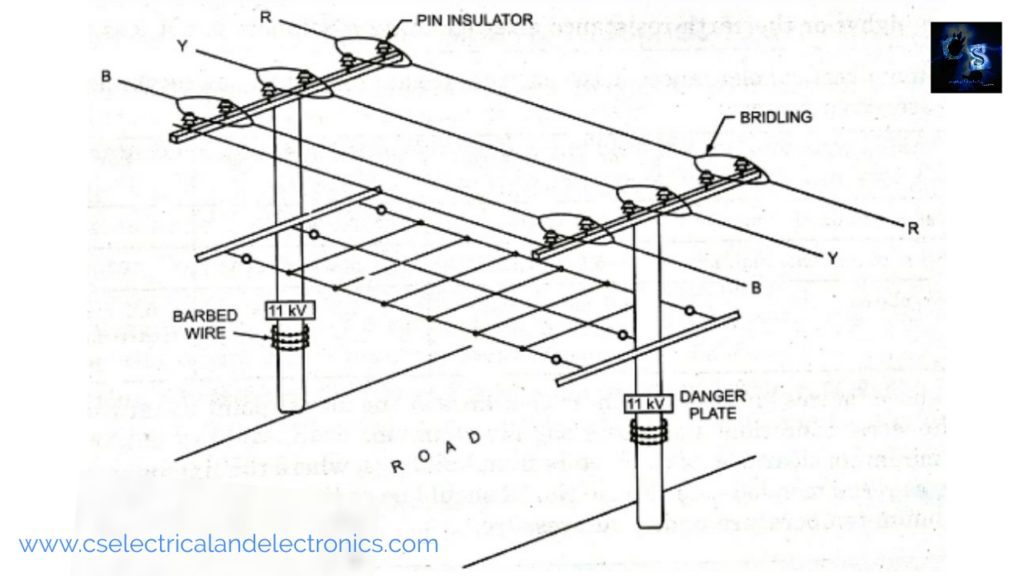
A guarding is provided for the safety of life, installation, and communication circuits. The guarding for 11 KV lines is provided at road crossings, canal crossings, railway crossings, crossing over lt lines, or communication lines.
Regarding guarding of line crossings or approaching each other IER 87 provides all-important guidelines, IER(Indian Electricity Rule) 88 provides that every guard wire shall be connected with the earth at each point at which electrical continuity is broken.
Every guard wire should have sufficient current-carrying capacity to ensure the circuit rendering is dead, without risk of fusing the guard wire or wires till the contact of any line wire has been removed. There are various other rules relating to guarding where lines cross trolley wires as mentioned in subrule (5) of IER 88.
Various guarding arrangements are shown below.
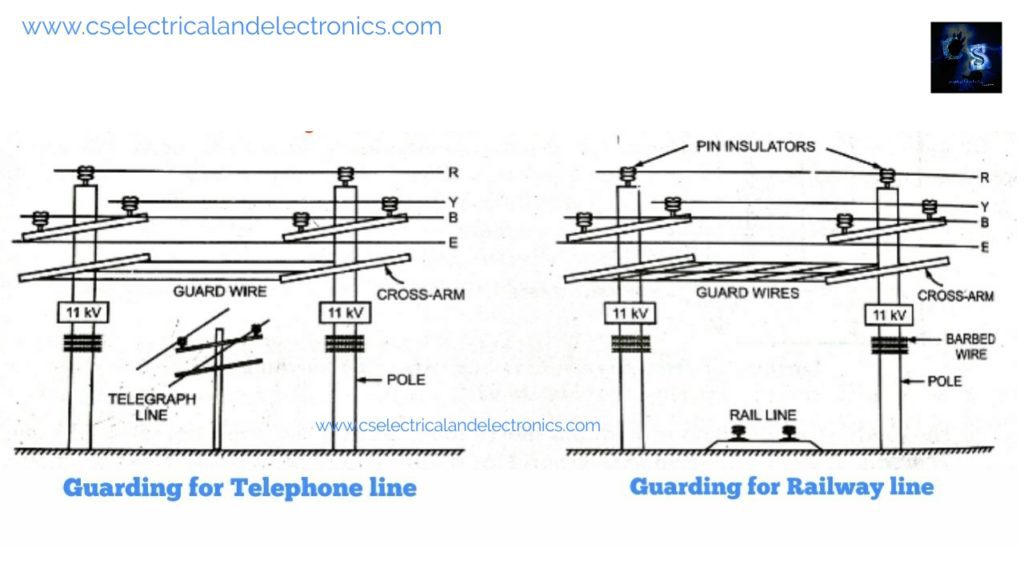
Cradle guarding is provided when the conductors are in horizontal or delta formation as in the case of 11 KV lines. The cradle guard is directly connected to an earth wire. If a line conductor breaks, it will fall on the guard, thereby blowing the fuse or tripping the coil of a circuit breaker.
When an lt line crosses a road or a railway line it is in the horizontal formation and therefore, at such places cradle guard is provided for lt lines also.
Cage guarding is provided on lt lines with vertical formation. The guard should be made of the same material as used for earth wire. In lt lines, the guard is connected with the neutral and insulated from the earth by means of a porcelain reel.
In case a live conductor breaks it comes in contact with the guard which causes a short-circuit between the live conductor and Neutral causing the fuse to blow or the circuit breaker to trip.
This was about “What Is Cross Arm, Jumper, And Guarding“. I hope this article may help you all a lot. Thank you for reading.
Tags: What Is Cross Arm, Jumper, And Guarding in Overhead Lines
Also, read:
- 10 Tips To Maintain Battery For Long Life, Battery Maintainance
- 10 Tips To Save Electricity Bills, Save Money By Saving Electricity
- 100 (AI) Artificial Intelligence Applications In The Automotive Industry
- 100 + Electrical Engineering Projects For Students, Engineers
- 1000+ Control System Quiz, Top MCQ On Control System
- 1000+ Electrical Machines Quiz, Top MCQs On Electrical Machines
- 1000+ MATLAB Simulink Projects For MTech, Engineering Students
- 50 Tips To Save Electricity At Home, Shop, Industry, Office
Author Profile
- Chetu
- Interest's ~ Engineering | Entrepreneurship | Politics | History | Travelling | Content Writing | Technology | Cooking
Latest entries
 All PostsApril 19, 2024What Is Vector CANoe Tool, Why It Is Used In The Automotive Industry
All PostsApril 19, 2024What Is Vector CANoe Tool, Why It Is Used In The Automotive Industry All PostsApril 13, 2024What Is TCM, Transmission Control Module, Working, Purpose,
All PostsApril 13, 2024What Is TCM, Transmission Control Module, Working, Purpose, All PostsApril 12, 2024Top 100 HiL hardware in loop Interview Questions With Answers For Engineers
All PostsApril 12, 2024Top 100 HiL hardware in loop Interview Questions With Answers For Engineers All PostsMarch 22, 2024Driver Monitoring Systems In Vehicles, Working, Driver Sleepy Alert
All PostsMarch 22, 2024Driver Monitoring Systems In Vehicles, Working, Driver Sleepy Alert

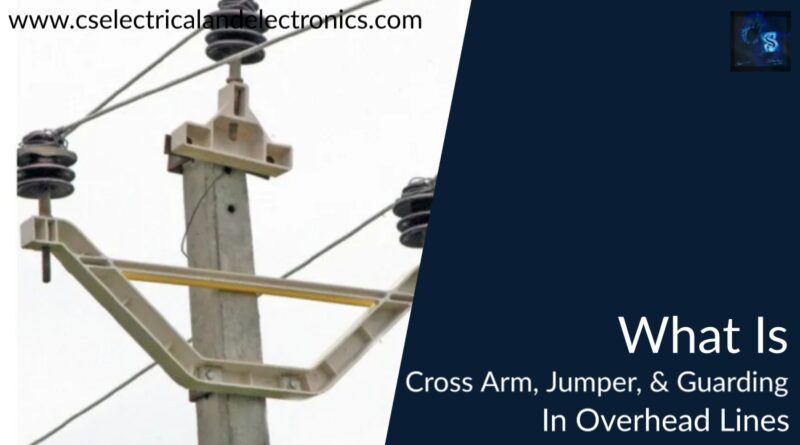







Nice explanation